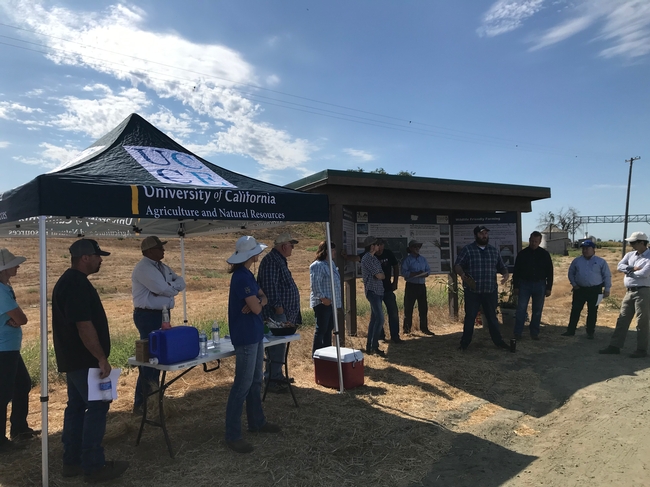
We began the meeting with “lightning talks” from organizations working on cover cropping and climate-smart agriculture, including UC Cooperative Extension, Contra Costa Resource Conversation District, Community Alliance with Family Farmers, and USDA-NRCS. We then showcased the cover cropping trial that we established in cooperation with Conservation Farms and Ranches. A CDFA Healthy Soils Program grant supports the Delta trial, which is part of a larger effort that includes our farm advisor colleagues in the Sacramento and San Joaquin Valleys – Sarah Light, Amber Vinchesi, and Scott Stoddard – along with Jeff Mitchell and Will Horwath at UC Davis.
This is the second of a three-year on-farm trial to evaluate warm-season, annual legume cover cropping between winter small grain crops compared with a standard dry fallow. Cover cropping is a management practice identified in the Healthy Soils Program as having the potential to improve soil health, sequester carbon, and reduce greenhouse gas emissions. Cover cropping is not a typical practice in the annual crop rotations of the Delta region, however, and summer cover cropping is particularly rare. The Delta is a unique agricultural region with unique environmental challenges. Some soils in the region are subsided due to oxidation of organic matter, and some soils suffer from salinity, having limited ability to leach salts due to low permeability soils and shallow groundwater. Because surface waterways provide water for irrigation, summer cover cropping with a legume has the potential to improve soil tilth at a time of year when the soil would otherwise be fallow and dry with no soil cover.
The soil type across the experimental site is a Valdez silt loam. The trial is approximately 4.5 acres and compares three replicates of two treatments: an irrigated cover crop and a dry, fallow soil in between small grain crops. A cover crop of cowpea (Vigna unguiculata cv. ‘Red Ripper') has been planted in July of 2018 and 2019 after small grain harvest and tillage operations. Irrigation is provided to the cover crop plots only. The cover crop is terminated in the fall ahead of tillage and planting of small grains. Soil properties tested to date include bulk density, salinity (EC), pH, total nitrogen (N), and total carbon (C). We have also evaluated cover crop characteristics and 2019 triticale yield.
Among the soil properties, we have observed essentially no change in bulk density, total C, and total N from the July 2018 baseline condition. We are monitoring salinity and pH semi-annually because we have observed these properties to improve in the cover-cropped plots. After one cover cropping season, salinity increased in both treatments, but it increased more in the dry fallowed plots, averaging 1.22 dS/m from 0 to 12 inches, compared to 0.64 dS/m in the cover crop (CC) treatment. Rainfall during the 2018-19 winter season leached salts in both treatments, but the CC treatment started the 2019 cover cropping season with a lower average rootzone salinity (0-36 in) of 0.78 dS/m, compared to 1.13 dS/m in the dry fallow (No CC) treatment. Soil at this site is acidic, which is typical for the region, but pH was observably higher in the CC treatments.
We made changes to our planting and irrigation scheme in 2019 – changing from flood to sprinkler irrigation – and this has improved cowpea stand in 2019, compared to 2018. There has been a lot of competition from volunteer wheat (2018)/triticale (2019) and weeds, but we decided in both years not to manage these with tillage or herbicides. Both add biomass to the soil, which is an objective of the Healthy Soils Program. Competition, however, likely impedes cowpea growth and nitrogen fixation, and future study should investigate how these soil properties are affected by single-species and mixed cover crop stands. At the end of the first cover cropping season, biomass largely favored the volunteer wheat. Of the total C added to the soil from biomass, the wheat contributed 42-71%, compared to 15-24% from the cowpea, across the three replicate plots. Of the total N added from biomass, the wheat contributed 68-87%, and the cowpea contributed 9-15%. The triticale forage crop (winter 2018-19) yielded 5.4 tons per acre for the CC plots and 6.3 tons per acre for the No CC plots, but there was high variability among subsamples. The overall field averaged approximately 5.5 tons per acre. More detailed methods and results are available in our preliminary report.
In summary, cover cropping, particularly in the warm-season, is not a typical management practice in the annual crop rotations of the Delta region. After the first year of a three-year study, cover cropping had no observed effect on bulk density, Total N, and Total C. We observed better salinity and pH conditions in the cover-cropped plots. Cowpea stand establishment and volunteer grain and weed competition have been the biggest challenges to growing a summer cover crop at this site, and the cover crop was not observed to improve cash crop yield in the following season. We will continue to monitor soil and cover crop properties in 2019 and 2020, and additionally, we will reach conclusions about greenhouse gas (CH4, N2O) emissions, which are being evaluated by our UC Davis colleagues.
This project is financially supported by the California Climate Investments program. We thank Dawit Zeleke and Morgan Johnson of Conservation Farms and Ranches for hosting the trial. We thank Tom Johnson of Kamprath Seed and Margaret Smither-Kopperl and Valerie Bullard of the NRCS PMC for information and advice on cover cropping.